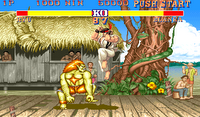After deciding on the plans, the next step is to decide what type of cabinet to build. There are literally an infinite amount of configurations for the control layout, type of monitor to use, type of controls, monitor orientation, etc. There's really not an ideal all-in-one solution (although many have tried). These decisions should be based around what type of games you want to play. If you mainly like driving games then you should plan on a steering wheel and some pedals. If you mainly like fighting games you should plan on 2 joysticks and a 6 button layout. You get the idea.
Since I'm building a "classics" cabinet, I've decided on one joystick with three buttons (most older games take 2 or less) and a vertical arcade monitor which is basically a regular monitor turned on its side. Most older games are taller than they are wide. Here are some screenshots of a vertical game and a horizontal game.
I will be able to play vertical games if I really want but they will have giant black bars on the top and bottom. Initially I don't think I'll be putting any on there though. I'm going to order a 17" Dell LCD monitor to play the games on. I'm a little unsure of using an LCD monitor because it's not "authentic" (the resolution is too good) but there are tricks that you can use to make the screen look close to the originals. I'm using an LCD because of size constraints - there's no room for a full-sized monitor to fit inside since I'm scaling it down to 80%.
Next, I have to decide on what type of joystick to use. There are a ton to choose from and not all joysticks are created the same. Each arcade game has controls that are specifically tailored for that particular game and when you are trying to build something that will play many different games you run into some problems. For example, Pac-man is a "4-way" game meaning the joystick will only move in 4 directions (up, down, left and right) but 1942 is an "8-way" game meaning tha the joystick will recognize the diagonals as well as the cardinal directions. If you try and play Pac-man using an 8-way joystick it is very frustrating because the game does not know what to do when a diagonal is pressed (because, for example, up and left would be pressed simultaneously) and it could result in a ghost catching you in the middle of a high score attempt!
There are numerous joysticks that try and solve this problem - the most popular solution is switching a restrictor plate on the bottom of the joystick so it will only be allowed to move in the desired directions. As you can imagine, this can be a pain when you are switching from game to game. The joystck I've decided to use is the Ultimarc 360. It is software based and it allows you configure the joystick to act any way you want (2-way, 4-way, 8-way, etc.) for whatever game you want. You can even customize it if you want. I've never used one before but I am anxious to set it up for this cabinet because it sounds like a true all-in-one solution. A great review of the joystick can be found on RetroBlast!.
Since most vertical games are fairly simple, I've decided to use only 3 "action" buttons on the control panel. I am also planning on having 4 additional buttons near the top of the control panel for administrative purposes. I need a button to start each game, to simulate inserting a cion into the machine, to pause in the middle of playing and to exit back to the front end). On the inside, I will be using my somewhat old junker computer (Gateway PIII, 40GB HDD, 256MB RAM) to run everything. This should be more than enough to run all the games I want.
That's all for now. In the next post I'll let you know the color and design that I've chosen for this project - it's going to be girly!
Thanks for looking!
Saturday, November 11, 2006
Subscribe to:
Post Comments (Atom)


No comments:
Post a Comment